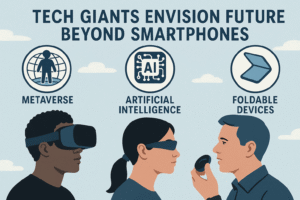
In the fast-evolving landscape of technology, the once-revolutionary smartphone is beginning to show its age. For over a decade, smartphones have been the centerpiece of our digital lives, acting as the go-to devices for communication, entertainment, navigation, and even work. But as innovation accelerates and user expectations shift, tech giants envision a future beyond smartphones—a future that promises to redefine how we interact with the digital world.
The Smartphone Plateau: Why Tech Giants Are Looking Ahead
The smartphone market, while still massive, is maturing. Annual upgrades are becoming incremental, and consumers are no longer as eager to upgrade devices every year. With hardware innovation slowing down and user fatigue growing, the world’s biggest tech companies are looking toward the next big platform shift.
Apple, Google, Meta, Microsoft, and Samsung—all are exploring technologies that could succeed smartphones as the dominant interface for digital interaction. This shift isn’t just about creating a new gadget; it’s about reshaping the ecosystem around how we live, work, and play.
What’s Next? Emerging Technologies on the Horizon
Here are some of the groundbreaking technologies these companies are investing in as they chart a path beyond the smartphone:
1. Augmented Reality (AR) and Virtual Reality (VR)
AR and VR are at the forefront of this movement. Companies like Meta are betting big on the metaverse—a virtual world where people can interact, work, and socialize using avatars. Meta’s Quest headsets and Apple’s Vision Pro are early examples of this push.
While current VR headsets are still bulky and expensive, future iterations promise to be lighter, more affordable, and seamlessly integrated into daily life. AR glasses, in particular, could eventually replace smartphones by overlaying digital information directly onto your field of vision.
2. Wearable Tech
Smartwatches, fitness trackers, and smart glasses are evolving rapidly. These devices aim to reduce our reliance on phones by delivering notifications, tracking health, enabling communication, and even offering digital assistants on the go.
Apple’s ecosystem, especially with the Apple Watch and AirPods, is already laying the foundation for a future where your phone is no longer the central device.
3. AI-Powered Assistants
Artificial Intelligence is becoming more context-aware and intelligent. Devices powered by advanced AI assistants (like Google Assistant, Siri, and Alexa) are beginning to handle tasks without needing a screen at all—voice commands, predictive actions, and smart automation are reshaping our interactions with technology.
Imagine a world where your assistant knows your routine, handles bookings, sends messages, and navigates your day—without ever needing to touch a phone.
Tech Giants’ Bold Plans: Beyond the Screen
As highlighted in this Wall Street Journal article, several tech giants are investing billions into the research and development of next-gen interfaces.
Google, for instance, has revived interest in smart glasses and spatial computing, while Apple’s Vision Pro aims to merge AR and VR into a single, usable device for everyday experiences. Microsoft, with its HoloLens, is targeting enterprise and industrial use cases, but consumer adoption is a long-term goal.
Samsung, meanwhile, is exploring foldable displays and flexible form factors that push the boundary of what a smartphone can be. Yet, even Samsung acknowledges that hardware must evolve beyond just screens and touch interfaces.
Challenges on the Road to a Post-Smartphone Future
Despite all the excitement, transitioning away from smartphones won’t happen overnight. There are significant challenges that must be addressed:
-
Affordability: Most advanced headsets or wearables cost far more than smartphones, limiting mass adoption.
-
Battery Life: Power efficiency remains a major hurdle for compact, always-on devices like smart glasses.
-
Privacy Concerns: As devices become more context-aware and always listening or watching, users are increasingly concerned about how their data is being used.
-
Infrastructure: Many of these future technologies require widespread 5G, low-latency networks, and edge computing that are not yet fully implemented.
Nevertheless, just as the iPhone revolutionized personal computing in 2007, the next decade could see an equally dramatic shift in how we interact with technology.
Why This Shift Matters to Businesses and Consumers
The move beyond smartphones isn’t just a tech novelty—it has real implications for how businesses reach customers and how individuals experience digital services.
-
For businesses, it means preparing for new marketing channels (like AR overlays or voice-first experiences), and rethinking UX/UI design.
-
For consumers, it could usher in an era of hands-free, screen-less interaction where technology becomes even more ambient and intelligent.
Startups and developers who understand these shifts early will have opportunities to build entirely new platforms, applications, and business models around the next computing interface.
Final Thoughts: A New Digital Dawn
The writing is on the wall—tech giants envision a future beyond smartphones, and they are actively building it. From wearable AI to immersive mixed-reality devices, the possibilities are vast and transformative. While smartphones will remain with us for a while longer, their dominance is slowly fading.
For the average user, this means exciting innovations are on the horizon. For businesses and creators, now is the time to adapt, explore, and innovate for a post-smartphone world.
As always, those who prepare early will shape the future—rather than be surprised by it.